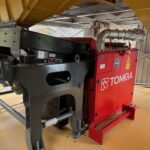The latest Annual Survey of Mining Companies released by the Fraser Institute in 2020 for the 2019 calendar year does not bode well for Africa – with five of the bottom 10 countries coming from the continent.
This includes the Democratic Republic of Congo which ranks a lowly 70th of 76. Why are investors giving these countries the thumbs down? And what can be done to turn their fortunes around?
GERARD PETER spoke to ASHLEY STEDMAN, a senior policy analyst at the Fraser Institute.
This article first appeared in Mining Review Africa Issue 4, 2020
Read the full digimag here or subscribe to receive a print copy here
Stedman is the co-author of the Fraser Institutes’ Annual Survey of Mining Companies 2019. The results are based on correspondence from mining executives from 76 jurisdictions around the world and is based on these jurisdictions’ geologic attractiveness (minerals and metals) and government policies that encourage or deter exploration and investment.
Stedman explains that the survey’s Policy Perception Index (PPI) is a “report card” to governments on the attractiveness of their mining policies. While geological and economic considerations are important factors in mineral exploration, a region’s policy climate is also an important investment consideration.
The PPI measures the overall policy attractiveness is composed of survey responses to policy factors that affect investment decisions
Participants are asked to answer questions on 15 policy factors that influence company decisions to invest in various jurisdictions.
The questions included uncertainty concerning the administration, interpretation, or enforcement of existing regulations; uncertainty concerning environmental regulations; taxation regime; political stability and trade barriers.
“The mining survey is the most comprehensive report on government policies that either attract or discourage mining investors,” Stedman states.
Based on the survey’s PPI, Finland displaced Saskatchewan (Canada) from the top spot this year with the highest PPI score of 100. Finland was followed by the Republic of Ireland in second place, which moved from fourth in the previous year.
Along with Finland and Ireland, the top 10 ranked jurisdictions are Nevada, Utah, Western Australia, Alberta, Idaho, Newfoundland and Labrador, Saskatchewan, and Arizona,
Meanwhile at the other end of the index, the 10 least attractive jurisdictions for investment (starting with the worst) are Venezuela, Zimbabwe, Tanzania, Argentina: Chubut, Argentina: Mendoza, Bolivia, the Democratic Republic of Congo (DRC), Zambia, Guinea (Conakry), and Argentina: La Rioja.
The median score for Africa on the investment attractiveness index showed a decrease of 5 points this year. In addition, Africa’s median PPI score decreased by almost 18 points making it the worst performing region in terms of policy environment for mining activities.
In terms of overall investment attractiveness, as a region, Africa ranks as the least attractive jurisdiction for investment with a median score of 51.52. Five African countries – Zimbabwe (75th), Tanzania (74th), the Democratic Republic of Congo (70th), Zambia (69th), and Guinea (68th) – ranked in the bottom 10 of the survey rankings this year based on policy. Zimbabwe was also amongst the bottom 10 in the previous seven years.
Three African jurisdictions jurisdiction were ranked in the global bottom 10 based on their overall investment attractiveness: Tanzania, Zambia, and Mali.
When considering policy factors alone, the DRC’s rank on the PPI improved from 82nd in 2018 to 70th in 2019.
“Despite this increase, there is still considerable room for improvement on the policy front,” Stedman adds.
“The DRC’s lack of transparency is a serious deterrent for investors. This year, respondents expressed increased concern over taxation (+22 percentage points), labour regulations/employment agreements (+14 percentage points), security, political stability, infrastructure and the quality of the geological database (+13 percentage points for each).”
Stedman adds that the DRC’s decline in the overall investment attractiveness rankings can largely be attributed to the fact that mining investors view the DRC’s mineral potential less favourably this year.
“This decline is reflective of investors’ views of pure mineral potential and not necessarily policy.”
So how does the country attract more investment? “There are many policy areas that require improvement. In general, investment dollars will flow to jurisdictions with attractive policies and governments need to focus on adopting competitive policies to attract valuable investment dollars.
“A sound and predictable regulatory regime coupled with competitive fiscal policies is key to making a jurisdiction attractive in the eyes of mining investors,” concludes Stedman.















